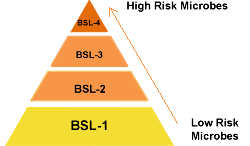Microbiology research labs vary in bio-safety levels (BSL) ranging from one (BSL-1) to four (BSL-4). Research on high risk microbes such as novel coronavirus, which could prove fatal to the world if they are not contained safely, are conducted in BSL-4 labs. High levels of safety protocols are needed to make sure pathogens do not escape.
The Wuhan Institute of Virology is also a lab with bio-safety level 4, which is currently researching on the SARS-CoV-2 (novel coronavirus). The lab was approved for research into even Ebola and other deadly viruses. However, this lab has been mired in controversies ever since the novel coronavirus epidemic broke out in China.

The director of the Wuhan National Biosafety Laboratory, Yuan Zhiming, has said there was 'absolutely no way' that the coronavirus originated from the institute." Even the WHO said the same after scientific research.
There are currently only 40 such high-end microbiology facilities globally and most are secure. CDC has provided more info on this.
BSL-1,2,3

Bio-safety level 1 labs study microbes that do not cause diseases in healthy adults. PPE such as lab coats, gloves and eye protection are used here. In the case of BSL-2, the lab access is restricted during work, and PPE with face shields are also worn. These labs also use bio-safety cabinet and have self-closing doors.
BSL-3 is a hi-tech lab that works with dangerous and exotic microbes like the bacteria that causes tuberculosis.
Along with the safety protocols of BSL-2, PPE is a must and respirators also may be required. Lab entrance has two sets of self-closing and locking doors with negative air pressure and airlocks to stop the air leaking out. They have hands-free sink and eyewash at the exit and exhaust air from the lab won't be re-circulated.
BSL-4 and High safety protocols
These labs work on viruses that pose a high risk of aerosol-transmitted infections that have no treatments or vaccines, like the COVID-19 virus. They are specially constructed. Change of clothing before entering and showering upon exit is necessary. All materials are decontaminated before exit, and researchers wear full body, air-supplied, positive pressure suit so that they don't breathe using the lab's air.

Experiments that usually take 30 minutes in other labs would take three hours in a BSL-4 lab, researcher Shi Zhengli told Hubei Daily in 2015 when the construction of Wuhan's facility was done, reports SCMP.
One has to pass through several doors in order to fetch something from the refrigerator. Though a difficult process, it must be done says Zhengli. The animals experimented on would undergo high-pressure sterilization before they are disposed while waste materials would be processed in the lab itself.
On top of all these, people using the lab would have their body temperatures recorded while researchers' blood would be regularly taken for testing. Even staff activities would be recorded as part of the safety protocol.
What if accidents happen?
Humans are prone to error and mistakes. Such incidents happen in these sophisticated labs which may cause harm, but empathy is important here. In such cases, Danielle Rintala, biological-safety officer for the University of Wisconsin–Milwaukee, says that bio-safety officers must remain calm while also listening carefully to what happened without judging the researcher/worker. The first mandate is to care about researcher's immediate welfare, reported Nature
Rintala says it should be made sure that researchers don't feel "blamed or shamed" for making a mistake. They shall not get a feeling of punishment, "but rather, to treat it as a learning experience." This makes the researcher to report problems freely and ask help from the bio-safety officers. After taking the situation under control, the officer shall investigate the problem and discuss it to prevent such errors in the future.
Learning why a researcher want to perform an experiment helps a manager to do the job, says Meghan Seltzer, manager of safety, health and security at the Howard Hughes Medical Institute's Janelia Research Campus in Ashburn, Virginia. "It helps me solve the safety problem better, which helps them get their research done, and I get excited about it," adds Seltzer.









